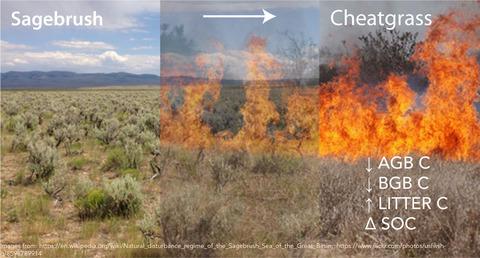当前位置:
X-MOL 学术
›
J. Appl. Ecol.
›
论文详情
Our official English website, www.x-mol.net, welcomes your feedback! (Note: you will need to create a separate account there.)
A synthesis of the effects of cheatgrass invasion on US Great Basin carbon storage
Journal of Applied Ecology ( IF 5.7 ) Pub Date : 2020-09-26 , DOI: 10.1111/1365-2664.13770 R. Chelsea Nagy 1 , Emily J. Fusco 2 , Jennifer K. Balch 1, 3 , John T. Finn 4 , Adam Mahood 1, 3 , Jenica M. Allen 5 , Bethany A. Bradley 2, 4
中文翻译:

白茅草入侵对美国大盆地碳储量影响的综合研究
更新日期:2020-09-26
Journal of Applied Ecology ( IF 5.7 ) Pub Date : 2020-09-26 , DOI: 10.1111/1365-2664.13770 R. Chelsea Nagy 1 , Emily J. Fusco 2 , Jennifer K. Balch 1, 3 , John T. Finn 4 , Adam Mahood 1, 3 , Jenica M. Allen 5 , Bethany A. Bradley 2, 4
Affiliation

|
- Non‐native, invasive Bromus tectorum (cheatgrass) is pervasive in sagebrush ecosystems in the Great Basin ecoregion of the western United States, competing with native plants and promoting more frequent fires. As a result, cheatgrass invasion likely alters carbon (C) storage in the region. Many studies have measured C pools in one or more common vegetation types: native sagebrush, invaded sagebrush and cheatgrass‐dominated (often burned) sites, but these results have yet to be synthesized.
- We performed a literature review to identify studies assessing the consequences of invasion on C storage in above‐ground biomass (AGB), below‐ground biomass (BGB), litter, organic soil and total soil. We identified 41 articles containing 386 unique studies and estimated C storage across pools and vegetation types. We used linear mixed models to identify the main predictors of C storage.
- We found consistent declines in biomass C with invasion: AGB C was 55% lower in cheatgrass (40 ± 4 g C/m2) than native sagebrush (89 ± 27 g C/m2) and BGB C was 62% lower in cheatgrass (90 ± 17 g C/m2) than native sagebrush (238 ± 60 g C/m2). In contrast, litter C was >4× higher in cheatgrass (154 ± 12 g C/m2) than native sagebrush (32 ± 12 g C/m2). Soil organic C (SOC) in the top 10 cm was significantly higher in cheatgrass than in native or invaded sagebrush. SOC below 20 cm was significantly related to the time since most recent fire and losses were observed in deep SOC in cheatgrass >5 years after a fire. There were no significant changes in total soil C across vegetation types.
- Synthesis and applications. Cheatgrass invasion decreases biodiversity and rangeland productivity and alters fire regimes. Our findings indicate cheatgrass invasion also results in persistent biomass carbon (C) losses that occur with sagebrush replacement. We estimate that conversion from native sagebrush to cheatgrass leads to a net reduction of C storage in biomass and litter of 76 g C/m2, or 16 Tg C across the Great Basin without management practices like native sagebrush restoration or cheatgrass removal.
中文翻译:

白茅草入侵对美国大盆地碳储量影响的综合研究
- 非本地侵入性布鲁氏球菌(草)在美国西部大盆地生态区的鼠尾草生态系统中普遍存在,与本地植物竞争并引发更多火灾。结果,石竹的入侵可能会改变该区域的碳(C)储存。许多研究已经测量了一种或多种常见植被类型的碳库:天然鼠尾草,入侵的鼠尾草和以草茅草为主(经常被烧毁)的地点,但这些结果尚待综合。
- 我们进行了文献综述,以鉴定评估入侵对地上生物量(AGB),地下生物量(BGB),垫料,有机土壤和总土壤中C储存的影响的研究。我们确定了41篇文章,其中包含386项独特的研究,并估计了不同水池和植被类型之间的碳储量。我们使用线性混合模型来确定C存储量的主要预测因子。
- 我们发现生物量C随入侵而持续下降:che草(40±4 g C / m 2)中的AGB C比天然鼠尾草(89±27 g C / m 2)低55%,而and草中的BGB C低62% (90±17 g C / m 2)比天然鼠尾草(238±60 g C / m 2)高。相比之下,石竹中的凋落物C(154±12 g C / m 2)比天然鼠尾草(32±12 g C / m 2)高4倍以上。与草皮或入侵的鼠尾草相比,草皮草顶部10 cm处的土壤有机碳(SOC)显着更高。自20厘米以下的SOC以来,与时间密切相关,因为最近一次起火,而在火灾后5年以上的厚草中观察到深层SOC的损失。不同植被类型的土壤总碳没有显着变化。
- 综合与应用。茅草的入侵会降低生物多样性和牧场生产力,并改变火势。我们的研究结果表明,草at入侵还导致鼠尾草替换过程中持续产生的生物量碳(C)损失。我们估计,如果不进行天然鼠尾草的修复或石笋的去除等管理措施,则从大面积的鼠尾草转化为石笋会导致整个大盆地中生物量和凋落物的碳储存净减少76 g C / m 2或16 TgC。


























 京公网安备 11010802027423号
京公网安备 11010802027423号